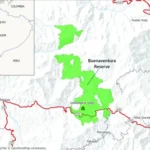Lay of the Land: The Buenaventura Reserve spans 9,947 acres of lower montane cloud forest in the southwestern Andes of Ecuador. This incredibly rich and varied protected area ranges from 1,500 to 3,600 feet in elevation and blends elements of the flora and fauna of two ecoregions — the Chocó, which runs from southern Colombia to the reserve area, and the Tumbesian, which runs up from northwestern Peru.

Focal Birds: About 370 bird species have been recorded in the reserve, according to the eBird database. These include two Endangered endemic bird species — the El Oro Parakeet and El Oro Tapaculo — as well as the Endangered Gray-backed Hawk. The latter species is found only in a handful of locations in Ecuador and far-northern Peru. A few other species regularly seen at the reserve include: Rufous-headed Chachalaca (listed as Vulnerable to extinction on the IUCN Red List), White-whiskered Hermit, Green Thorntail, Violet-tailed Sylph, Green-crowned Brilliant, Crowned Woodnymph, Violet-bellied Hummingbird, Yellow-throated and Choco Toucans, Black-and-white Owl, Guayaquil Woodpecker, Red-masked Parakeet, Club-winged Manakin, Long-wattled Umbrellabird (Vulnerable), Ochraceous Attila (Vulnerable), Bay and Song Wrens, Swainson’s Thrush (a winter resident), and Bay-headed, Golden, and Silver-throated Tanagers.

Other Wildlife: White-nosed Coati, Central American Agouti, Mantled Howler Monkey (Vulnerable), Brown-throated and Hoffmann’s Two-toed Sloths, and Red-tailed Squirrel. Many other mammals occur, including the secretive Puma, Ocelot, and Northern Tiger Cat (Vulnerable). Plant life includes many rare species, such as a recently discovered magnolia that is still being described.
When to Visit: A visit to Buenaventura Reserve will be rewarding at any time of year, but note that the rainy season runs from December to March. From October to June, male Long-wattled Umbrellabirds are an outlandish sight as they display on a lek near the lodge: The birds lean forward, extending and flaring their long black-feathered wattles, then utter low “mooing” calls. See a male umbrellabird in action here.
Conservation Activities: The reserve was established in 1999 by ABC partner Fundación de Conservación Jocotoco to protect the El Oro Parakeet, first described in 1980, and the El Oro or Ecuadorian Tapaculo. The reserve has been expanded several times since, with support from ABC and other partners. Degraded habitats acquired for the reserve have been either allowed to regenerate or replanted with native species. The El Oro Parakeet population has thrived under protection and benefited from a successful nest box program.

El Oro Province, where the reserve is located, is now mostly an agricultural landscape, with only a small percentage of original cloud forest remaining. Recent reserve expansions aim not only to provide protection for species, but also to connect already-protected habitats and higher-elevation areas that provide extra insurance if species’ ranges push higher due to the effects of climate change.
Directions: One of the easiest ways to reach Buenaventura is to fly from Quito to the southwestern town of Santa Rosa. From there, it’s an hour-and-a-quarter drive to the reserve. The reserve can also be reached via a four-hour drive from Guayaquil.

Where to Stay: The Umbrellabird Lodge is located on the property and features a deck and dining area thronging with hummingbirds that visit the feeders there. Dining companions may include a coati or two. Accommodations include five cabins, each with a private bathroom. The reserve’s extensive trail system can be accessed from the lodge. More information can be found here.
In the Area: Several other stellar Jocotoco reserves dot southern Ecuador. Many visitors to Buenaventura continue on to Tapichalaca Reserve (higher-elevation cloud forest and home to the Jocotoco Antpitta), and to dry-forest habitats at Utuana and Jorupe Reserves, close to the Peruvian border.